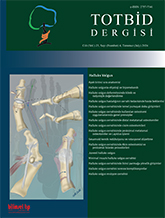
The Akin osteotomy is a commonly used procedure in the treatment of hallux valgus deformity. This osteotomy was first described by Akin in 1925 and was initially suggested as a primary treatment modality for hallux valgus. However, today it is generally preferred as an additional procedure after metatarsal osteotomies. Clinical and radiological evaluation of patients is important in determining the indication for the procedure. Hallux valgus interphalangeus angle (HVIP) and distal joint set angle (DESA) are important parameters to consider when deciding on proximal phalanx osteotomy. Basically, if the HVIP is to be corrected, the osteotomy should be performed at the distal proximal phalanx, and if the DESA is to be corrected, the osteotomy should be performed more proximally. Paying attention to the integrity of the lateral cortex in the application of the Akin osteotomy is one of the critical points of the technique. Screw, staple, monofilament wire, fusible suture materials, Kirschner wire, plate or combinations of these can be used for fixation after osteotomy. Proximal phalanx osteotomy usually has a low complication rate, but fracture and seperation of the lateral cortex and the use of additional fixation materials may increase complication rates. In conclusion, the Akin osteotomy plays an important role in hallux valgus surgery and should be performed with caution, although complications are few.